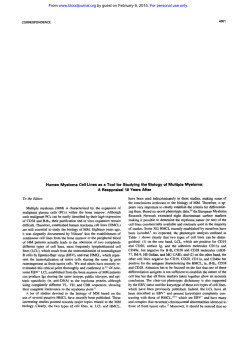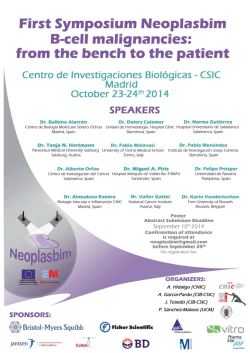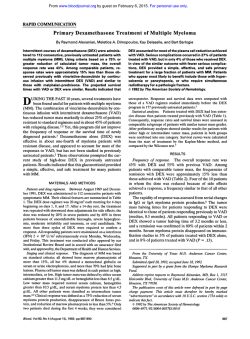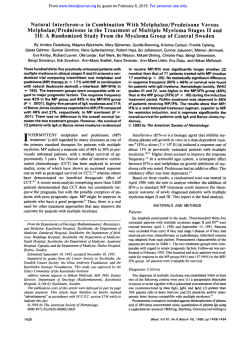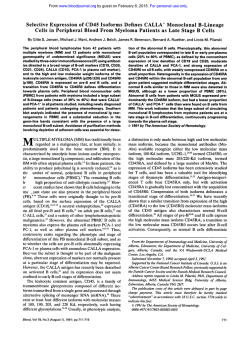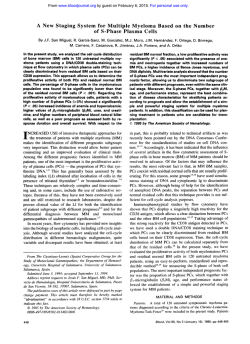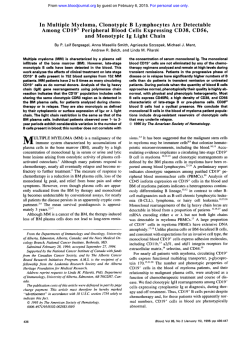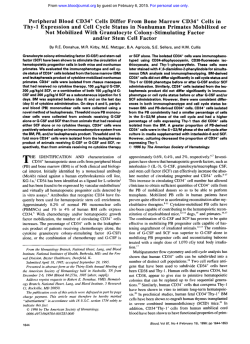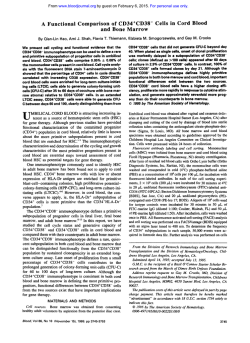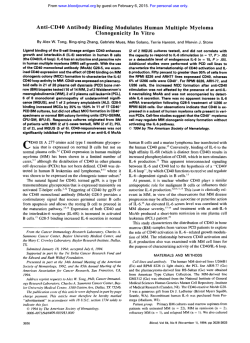
Differential Mobilization of Myeloma Cells and Normal
From www.bloodjournal.org by guest on February 6, 2015. For personal use only. Differential Mobilization of Myeloma Cells and Normal Hematopoietic Stem Cells in Multiple Myeloma After Treatment With Cyclophosphamide and Granulocyte-Macrophage Colony-Stimulating Factor By Yair Gazitt, Erming Tian, Bart Barlogie, Chris L. Reading, David H. Vesole, Sundar Jagannath, Judith Schnell, Ron Hoffman, and Guido Tricot Peripheral blood stem cells (PBsCs) mobilized with highdose chemotherapy and hematopoietic growth factors are now widelyused t o support myeloablative therapyof multiple myeloma and effect complete remissions in up t o 50% of patients with apparent extension of event-free and overall survival. Because tumor cells are present not only in bone marrow, but also in virtually allPBSC harvests, it is conceivable that autografted myeloma cells contribute t o relapse after autotransplants. In this study, the kinetics of mobilization of normal hematopoietic stem cells were compared with those of myeloma cells present in PBSC harvests of 12 patientsafter high-dose cyclophosphamide and granulocyte-macrophage colony-stimulating factor administration. CD34+ and CD34+Lin-Thy+ stem cell contents were measured by multiparameter flow cytometry, and myelomacells were quantitated by immunostaining for therelevant Ig light chain and by a quantitative polymerase chain reaction for the myeloma-specific CDRlllsequence. Results indicated marked heterogeneity in the percentages of mobilized stem cells among different patients(0.1% t o 22.2% for CD34' cells and 0.1% t o 7.5% for CD34+Lin-Thy+cells, respectively). The highest proportions ofhematopoietic progenitor cells were observed early during apheresis, with 9 of 12 patients mobilizing adequate amounts of CD34' cells for 2 autotransplants (>4 x 106/kg) within the first 2 days, whereas peak levels (percent and absolute numbers) of myeloma cells were present on days 5 and 6 (0.5% t o 22.0%). During the lastdays of collection, mobilized tumor cells exhibited more frequently high labeling index values (1% to 10%; median, 4.4%) and an immature phenotype (CD19'). The differential mobilization observed between normal hematopoietic stem cells and myeloma cells can be exploited t o reduce tumor cell contamination in PBSC harvests. 0 1996 by The American Societyof Hematology. A completion of cyclophosphamide treatment and continued daily until the completion of the PBSC collections. A Quinton double lumen catheter was inserted in the subclavian vein for stem cell apheresis. Apheresis procedures were performed on a Cobe Spectra Blood Cell Processor (Lakewood, CO) and PBSCs were collected once the leukocytes count exceeded 0.5 X 1Oy/Land platelets approached 50 X 10yL(untransfused). Collections continued until at least 6 X lo* mononuclear cellsikg were obtained (usually within 4 to 6 days) or for a maximum of 14 days. However, there was no set target for CD34' or for CD34+Lin-Thy+ cells. All patients signed an informed consent form approved by the local Institutional Review Board. Flow sorting of plasma cellsand generation of the CDRIIIprimer for ASO-PCR. Ficoll-Hypaque-separated BM mononuclear cells (BMMCs) were stained for the CD38 and CD45 antigens (CD45fluorescein isothiocyanate [F'ITC]; CD3S-phycoerythrin [PE]; Becton Dickinson [BD], Mountain View, CA). The CD38b"gh'CD451"" cells were sorted using a FACStar Plus cell sorter (BD) as described previously.'3.18DNA extraction, generation of the CDRIII primers, and radiolabeled ASO-PCR reaction were performed as previously de~cribed.'~."-~' Dilution curves of myeloma cell DNA between 10% and 0.001% myeloma cell DNA were generated for each patient by diluting myeloma cell DNA into normal peripheral blood lymphocytes DNA, as previously described.l3.Iy Autoradiograms were scanned densitometrically and quantitation of myeloma cells in UTOLOGOUS TRANSPLANTATION is now frequently used in the treatment of patients with multiple myeloma (MM)."4 Complete remissions (CRs) are observed in up to 50% of patients with newly diagnosed MM, but, unfortunately, relapses remain a pr~blem.',~" Compared with standard autologous bone marrow (BM) transplants, peripheral blood stem cells (PBSCs) procured after the administration of high-dose cyclophosphamide and/or hematopoietic growth factors significantly reduce the duration ofBM aplasia and hence treatment-related morbidity and mortality.'"' Because MM is a disease considered to be restricted to the BM, the concentration of myeloma cells in PBSCs was felt to be negligible. However, we and others have documented tumor cells in PBSC harvests with a frequency of 0.01% to greater than This observation prompted the exploration of hemopoietic stem cell selection as a means of reducing tumor cell ~ontamination.'~ We have focused on a CD34+ subcompartment that expresses Thy+ and Lin(CD34', Thy+, Lin-) and is composed of cells capable of unlimited self-renewal and multilineage differentiation.14"' This fraction contains less than 0.001%myeloma cells, based on polymerase chain reaction (PCR) amplification of the CDRIII sequence.13 In the current study, high-dose cyclophosphamide and granulocyte-macrophage colony-stimulating factor (GMCSF) were administered for PBSC mobilization. Marked heterogeneity was observed (>50-fold) among different patients in the number of stem cells mobilized, peaking during the first 3 days of apheresis, whereas myeloma cells were present then in low numbers but increased by more than 2 logs on days 5 to 6. MATERIALS AND METHODS Mobilization and procurement of PBSCs. Patients with recently diagnosed (N = 5) or previously treated myeloma (N = 7) received 6 g/m' of cyclophosphamide over 12 hours. GM-CSF was initiated at a dose of 250 pglm2 subcutaneously within 24 hours after the Blood, Vol 87, No 2 (January 15), 1996: pp 805-811 From the Department of Medicine, Division of Hematology-Oncology, University of Arkansas for Medical Sciences, Little Rock, AR; and SyStemix, Palo Alto, CA. Submitted June 15, 1995; accepted August 30, 1995. Supported by National Institutes of Health Grants No. POI-CA 55819 and CA 539340. Address reprint requests to Yair Gazitt, PhD, Department of Medicine, Division of Hematology-Oncology, University of Arkansas for Medical Sciences, 4301 WMarkham Slot 508,Little Rock, AR 72205. The publication costs of this article were defrayed in part by page charge payment. This article must therefore be hereby marked "advertisement" in accordance with 18 U.S.C. section 1734 solely to indicate this fact. 0 19% by The American Society of Hematology. 0006-4971/96/8702-0025$3.00/0 805 From www.bloodjournal.org by guest on February 6, 2015. For personal use only. 806 PBSCcollections was performed by log linearregressionas previously described."." Quantitation of CD34'Lin-Thy' stem cells. Stem cells were de(1 0' cells) for CD34 tected by staining samples from apheresed blood using anti CD34-PE(HPCA-2;BD)andforThy(CD,90) using biotin-labeled GM 201 (SyStemix, Palo Alto, CA), followed by RED FITC670-streptavidin(Systemix). Lin' cellswerestainedwith conjugated antibodies to CD14,CDIS, CD2, CD16, CD19, and antiglycophorin (all from BD). Isotypic controls corresponding to the antibody isotypes and the proper fluorochrome were used to deterIgG l-biotin and avidin-RED670 were mine the background staining. used as a control for the Thy antibody. Propidium iodide was added to all tubes to exclude dead cells. Tubes were run on a FACSCAN BOW cytometer (BD). Six parameters (FS, SS, PI, FITC, PE, and Red 670) were examined in listmode using the ListView software (Phoenix Flow Systems, San Diego, CA). The cells were sequentially gated from viable nucleated cells to the lymphoblastoid region and then to each of the two color combinations, ie. CD34 versus Lin and CD34 versus Thy. Each fluorochrome was colorgated. Fifty thousand cells were analyzed. Sruiningfor myeloma cells. Staining of myeloma cells was per(50,000 cellsfromapheresissamples)after formedoncytospins ethanol fixation (30 minutes at 4°C). Slides were stained for both K and X light chains of human Ig (rabbit antibody-Rhodamine conjugate; Dako, Carpinteria, CA). Plasma cells were identified by positivestainingforthepertinent light chainand by theirlymphoid/ plasmacytoid morphology. Positive staining for the irrelevant light chain was always less than 10% of the relevant light chain. At least S00 cells were scored. Staining of immuture myeloma cells und determination of plusma cell labeling index (PCLI). Severalmethodsfordetermination of PCLI were tested using different anti BrdU antibodies and different cell denaturationprotocolsasdescribed previously.2' The best results were obtained using the procedure described by Lokhorst et al." Briefly, samples from apheresed blood (10' cells) were allowed to incorporate bromodeoxyuridine ( I 0 pmol/L BrdU for 1 hour at 37°C). Subsequently, aliquots of 50,000 cells were cytospun, fixed with ethanol, air-dried, andtreated with 2 N HCI (30 minutes at room temperature) to denatureDNA.Afterneutralization in phosphatebuffered saline (PBS), slides were stained for K and A light chains as described above and for BrdU with anti-BrdU antibodies (mouse monoclonal; Dako), followedby antimouse-FITC (Jackson Immunochemicals, West Grove, PA). Double-stained cells were counted as cycling p k m d cells. Cycling plasma cells were identified by positive staining for the relevant light chain (red), by positive staining for BrdU (green), and by their lymphoidlplasmacytoid appearance. Positive staining for the irrelevant light chain was less than 10% of the relevant light chain. At least 500 plasma cells were scored. Mouse lgGI was used as a control for background staining for the BrdU antibody. This procedure wasused successfully in our laboratory for more than 1 year to monitor more than 400 patients with significant correlationbetweendiseaseactivityandPCLI(Gazitt,manuscript in preparation). Immature plasma cells were detected by cytoplasmic staining for K/A lightchain(rhodamine-conjugatedantibodies), as described above,andfor CD19' usingFITC-anti-CD19antibody(mouse, monoclonal; BD). Most CDIY' cells were small lymphocytoid,with predominantmembranestaining for CD19. In 2 patients. CD19' cells had the appearance of plasmacytoid cells with weak staining for cytoplasmic CD19 antigen and positive staining for the relevant light chain. Positive stainingof CD19' cells with the irrelevant light less than 1070 of therelevantlightchain. At chainwasalways least S00 plasma cells were scored. Mouse FITC-IgGI was used as isotypic control for background staining for the CD19 antibody. GAZITT ET AL RESULTS The time courseof stem cell mobilization for 4 representative patients is depicted in Fig I . Maximum proportions of CD34' and CD34'Lin-Thy' were observed on days 1 to 3, ranging from 1.8% to 22.2% and 0.48% to 8.2%.respectively. Figure 2 portrays the cumulative amount of CD34' stem cells in the 12 MM patients studied. Sufficient quantities of CD34+ cells perkilogram fortwo autotransplants (>4 X 10') were obtained after two collections in 9 of the 12 patients. Eight patients mobilized greater than 10 X loh/ kg of CD34' cells within the first 3 days of collection. Three patients did not mobilize well. The proportions of myeloma cells in PBSC harvests of 4 patients, including the percentages of light chain restricted B cells (PLC), their labeling index (PCLI), and the proportion of immature myeloma cells(CD19') are depicted in Fig 3. In all 4 patients, mobilization of myeloma cells peaked on days S and 6, with PCLI values ranging between 3.1 % and 7.5% on these days. Maximum concentrations of light chain-restricted CD19' cells (presumedto represent preplasmacytic myeloma cells) usually coincided with peak values of PCLI. The cumulative amountof myeloma cells in the I2 myeloma patientsis depicted in Fig 4. Ten patientsmobilized greater than S X 107/kg and 6 greater than 1 X lORkgmyeloma cells during the 6 days of apheresis. One patient did not mobilize significant amounts of myeloma cells. In the other 1 1 patients, greater than 75% of myeloma cells were collected during the last 2 days of apheresis. Figure S summarizes the proportions of CD34'. CD34'Lin Thy*, and myeloma cells duringthe consecutive days of PBSC apheresis. Median percentages of maximum CD34' and CD34'Lin-Thy' cells were 5.5% (range, 0.2% to 22.2%) and 2.7% (range. 0.1% to 8.2%), respectively. Both cell populationswere largest on days 1 to 3, with a subsequent significant decline reaching a minimum by day 6 ( P < .001). In contrast, only 2 of 12 patients had ~ 2 . 5 % myeloma cells by immunocytochemistry in their PBSC collections on days 1 and 2, compared with 1 I of 12 patients by day 6. A median of 4.4% myeloma cells (range, 1.6%to 10.9%) werecycling, most frequentlyon days 4 to 6 of PBSC collection. Similarly, CD19'lightchain-restricted cells peaked on day 6, with a median of 5.1% (range, 0% to 16%;results not shown). Theleast overlap between hematopoietic progenitor and myeloma cell mobilization was observed on days I and 2. PCR-basedquantitation of minimalresidual disease is more sensitive (2 to 3 logs) than immunofluorescence-based quantitation of tumor cells. Therefore, quantitation of myeloma cells in PBSC collections was also performed by PCR amplification of the clone-specific CDRIII sequence. Representativeresults from 6 patients (B.D., H.R., B.L., L.J., M.G.. and D.P.) are shown in Fig 6. The dilution curves (left panels) indicate a sensitivity of detection of I myeloma cell in 10,000 to100,000nonmyeloma cells. A daily increase in the number of myeloma cells in PBSC collections (right panels) was seen. Densitometric scanning of the autoradiograms and quantitation by log-linear regression in 3 patients (B.D., H.R., and B.L.) showed a low content of myeloma From www.bloodjournal.org by guest on February 6, 2015. For personal use only. DIFFERENTIAL MOBILIZATION OF MYELOMA AND STEMCELLS 807 Patient B.D. Patient B.L. 12.5 12 5 UCD%+ ICD%+/Thy+ 10 0 Aphemia Patient H.R Patient M.G. 20 m b- 10 e 5 Fig 1. Mobilization of stem cells in PBSC harvests of MM patients. Percentages of hematopoietic progenitor cells during consecutive days of apheresis in 4 patients. E O5 od Aphemsii Aphereais cells during the first days of apheresis (<0.01%, 1.2%, and 0.1%, respectively), with subsequent daily increases of up to one log, reaching 6.5%, 16.9%, and 22%, respectively, on day 6. Two patients (L.J. and D.P.) had already high levels of myeloma cells on day 1 (4.4% and 9.6%, respec- tively), with no obvious change during subsequent days of apheresis. One further patient (M.G.) had a low baseline level of myeloma cells (0.15%), with no further increase during subsequent days of apheresis. A significant correlation was observed between the levels of myeloma cell measured by the PCR method and by immunofluorescence with R values of 0.93 to 0.97. KINETICS OF MOBILIZATION OF CD%+ STEMCELLS 4b =DAY1 EDAYZ [IDDAY3 DISCUSSION mDAY4 Mobilization of PBSCs with high-dose chemotherapy alone or in combination with hematopoietic growth factors results in a 10- to 100-fold increase in the number of circulating hematopoietic progenitor ~ e l l s ~ and ~ . ’ effects ~ prompt, complete and durable engraftment after myeloablative treatment.”” Probably not unexpectedly, this approach also leads to mobilization of tumor ~ e l l s , ’ ’ ~including ~~ myeloma P8 IQ 0 + C.E. R.S. H.R. C.I. D.P. C.G. M.oG. L.J. B.L. B.D. M.G. B.S. Fig 2. Cumulative number of CD34’ stem cells in MM patients. Absolute daily amounts of CD34+ stem cells per kilogram were calculated from the total WBC count per collection, the percentage of CD34+ cells, and the patient‘s body weight. Myeloma cells are present in virtually all mobilized PBSC harvests with a frequency of 0.01% to greater than 10%.l3 Depletion of myeloma cells can be achieved by positive selection for CD34+cells” or, morecompletely, by selection for CD34+Thy+Lin- stem cells.’3 This is the first detailed study assessing, simultaneously, the kinetics of mobilization of both hematopoietic progenitor cells and myeloma cells, including their proliferative capacity and the immature myeloma cell phenotype. The highest proportions of progenitor cells (CD34’ and CD34+ThytLincells) were observed during the first 2 days of apheresis, when the total white blood cell (WBC) count was still low (0.5 to 2 X 109/L). More than 4 X 106/kg CD34+ cells, sufficient for two auto transplant^,^ were collected during the first 2 days in 9 of the 12 patients. Two of the three patients From www.bloodjournal.org by guest on February 6, 2015. For personal use only. GAZllT ET AL 808 Patient B.D. Patient B.L. "1 301 151 OPL I PCCI L C lD 1 9 K =PLC I P CI LClD 1 9 K Apheresis Apheresis Patient H.R. Patient M.G. Fig 3. Mobilization of my- Apheresis eloma cells in P B X harvests of MM patients. Percentages of plasma cells, light-chain restricted CD19+ cells, and cycling plasma cells during consecutive days of apheresis.Plasmacells of are expressed as a percentage the total number of cells in the daily collections. PCLl and CD19 cells are expressed as a percentage of the total number of plasma cells scored. O P LI PCCI LClD 1 9 K Aphemk whodidnot mobilize adequate amounts of CD34+ cells had prolonged prior treatment with alkylating agents (> 12 months), resulting in permanent stem cell damage, as reported before.' The proportions of CD34' cells in these 3 patients were comparable to those observed in peripheral blood of unmobilized MM patients (<l%). In contrast to stem cells, the highest concentrations of myeloma cells (>75% of total tumor cells) were collected during days 5 and 6 of apheresis, when the percentage and absolute number of progenitor cells were already rapidly declining. Hence, an ideal window for PBSC collection with KINETICS OF MOBILIZATION OF MYELOM4CELLS '"1 M.G. C.I. hl0.G. B.L. D.P. R.S. B.O. C.E. C.G. HR. 8.5. L.J. Fig 4. Cumulative number of myeloma cells in MM patients. Absolute daily amounts of myeloma cells per kilogram were calculated from the total WBCcountpercollection, the percentage of light chain-restricted myeloma cells, and the patient's body weight. high progenitor cell content and minimal myeloma cell contamination exists during the first few days after W C and platelet counts start to recover. Moreover, during the last days of apheresis, a significant proportion of myeloma cells was cycling and exhibited a more immature phenotype (CD19+). Both immunocytochemical and PCR-based methodologies detected comparable amounts of myeloma cells in the daily collections (R values of 0.93 to 0.97). The more sensitive PCR-based assay showed a daily increase in concentration of myeloma cells by 1 log in several patients. Whether mobilization of myeloma cells is the result of cyclophosphamide treatment or the administration of hematopoietic growth factor remains unknown. We are currently conducting a study comparing the yield of CD34+ cells and degree of myeloma cell contamination in MM patients mobilized with either G-CSF or G-CSF plus cyclophosphamide. A direct comparison between G-CSF and cyclophosphamide would have been preferable, but cyclophosphamide as a sole mobilizing agent results in lower quantities of CD34+ cells per kilogram, CD34+CD38- cells per kilogram, and CFUGM per kilogram when compared with G-CSF alone." The fact that most of the multilineage hematopoietic growth factors are capable of mobilizing hematopoietic stem cells as well as cells12.13.27.28.31-34confirms the notion that cytokines are not cell-type specific, although the differential mobilization observed between hematopoietic progenitor cells and myeloma cells suggests a greater sensitivity of hematopoietic progenitor cells to cytokines compared with myeloma cells. The molecular basis of homing of hematopoietic progenitor cells and tumor cells to the BM and their release into the peripheral blood is not well under~tood.3~ Sustained high From www.bloodjournal.org by guest on February 6, 2015. For personal use only. DIFFERENTIALMOBILIZATION OF MYELOMAANDSTEM 809 CELLS levels of circulating growth factors may downregulate the expression of adhesion molecules such as VLA-4, ICAM- I , and ELAM-l on the surface of stem cells, endothelial cells, and myeloma cells. In support of this hypothesis is the recent observation ofhigh levels of circulating hematopoietic RD. H.R. A B.L. r a V APHERESIS D.P. Y r L- W IO ' IO IO ' 10' IO ' I I 2 1 . I . -= * .a .- l M Y 2 .. 4 . f .- MMY Y4 5 M Y 3 - M Y 6 APHERESIS * 2 ; ; . MM YM Y 2Y 3 4 * ?" j *: MV5 . M Y 6 Fig 5. Comparison between mobilization of stem cells and myeloma cells in 12 patients. Stem cells were measured by flowcytometry and myeloma cells by immunocytochemistry as described in the Materials and Methods.A significant decrease ( P < .001) in the median concentrationof CD34' cells from 5.5% on day 2 t o 0.8% on day 6 (Fig 3A) concurs with a decrease in CD34'Lin-Thy' cells from a median of2.7% on day 1t o 0.29% on day 6 (Fig 38). Medianpercentages of myeloma cells were low ondays l through 3 10.3546, 0.650/0, and 1.846, respectively) and increased markedly ondays 4 through 6 (4.2%. 5.7%. and 11.2%; Fig 3C). Fig 6. ASO-PCR amplification of theCDRlll band the dailyin PBSC collections of6 MM patients. The left panel shows the dilution curve of DNA (10% t o 0.001%1 from purified myeloma cells with normal lymphocyte DNA. Lanes d, through ds represent DNA from PBSC harvests of these patients duringconsecutive days of collection. growth factors in umbilical cord blood"and their effect on the expression of the adhesion molecules, ELAM-l and ICAM-I.37Umbilical cord blood induces rapid hematopoietic engraftment after myeloablative treatment. Interestingly, CD34' cells express increased levels of L-selectin after PBSC mobilization strategies, which correlated withthe speed of hemopoietic engraftment.3x While depletion methods for myeloma cells from PBSCs are currently being we recommend that, in the absence of such methods, large volume exchanges early after leukocyte and platelet recovery are perf~rmed.'"~~' Our conclusions are supported by the absence of breast cancer cells, as measured by sensitive immunocytochemistry and clonogenic assays, in single day large volume PBSC collections.." ACKNOWLEDGMENT The authors thank Christina Bewley for her dedicated secretarial assistance. REFERENCES I . Jagannath S, Vesole D, Glenn L, Crowley J, Barlogie B: Lowrisk intensive therapy for multiple myeloma with combined autologous bone marrow and blood cell support. Blood 80:1666. 1992 2. Attal M. Huguet F, Schleifer D. Payen C. Laroche M, Foumie B, Maziere B, Pris J. Lament G: Intensive combined therapy for previously untreated aggressive myeloma. Blood 79: I 130, 1992 3. Fermand J, Chervet S, Ravaud P. Divine M. Leblond V. Dreyfus F, Mariette X, BruetJ-C: High dose chemoradiotherapy and From www.bloodjournal.org by guest on February 6, 2015. For personal use only. 810 autologous blood stem cell transplantation in multiple myeloma. Blood 82:2005, 1993 4. Barlogie B, Jagannath S, Vesole D, Tricot G, Naucke S, CoplandM, Crowley J: Total therapy for newly diagnosed multiple myeloma. Blood 82:198a, 1993 (abstr, suppl 1) 5. Harousseau JL, Attal M, Divine M, Marit G, Leblond V, Stoppa A-M, Bourhis J-H, Caillot D, Boasson M, Abgrall J-F, Facon T, Linassier C, Cahn J-Y, Lamy T, Troussard X, Gratecos N, Pignon B, Auzanneau G, Bataille R: Autologous stem cell transplantation after first remission induction treatment in multiple myeloma: A report of the French Registry on autologous transplantation in multiple myeloma. Blood 85:3077, 1995 6. Vesole D, Barlogie B, Jagannath S, Cheson B, Tricot G, Crowley J: High dose therapy for multiple myeloma: Improved prognosis with better supportive care and double transplant. Blood 84:950, 1994 7. Tricot G, Jagannath S, Vesole D, Nelson J, Tindle S, Miller L, Cheson B, Crowley J, Barlogie B: Peripheral blood stem cell transplants for multiple myeloma: Identification of favorable variables for rapid engraftment in 225 patients. Blood 85:588, 1995 8. Bik To L, Shepperd KM, Haylock DM, Dyson PG, Charles P, Thorp DL, Dale BM, Dart GW, Roberts MM, Sage R E , Juttner CA: Single high dose of cyclophosphamide enable the collection of high numbers of hematopoietic stem cells from peripheral blood. Exp Hematol18:442, 1990 9. Haas R, Dick Ho A, Bredthauer U, Cayeux S, Egerer G, Knauf W, Hunstein W: Successful autologous transplantation of blood stem cells mobilized with recombinant human granulocyte-macrophage colony stimulating factor. Exp Hematol 18:94, 1990 10. Kotasek D, Shepherd KM, Sage RE, Dale BM, Norman JE, Charles P, Gregg A, Pillow A, Bolton A: Factors affecting blood stem cell collections following high-dose cyclophosphamide mobilization in lymphoma, myeloma and solid tumors. Bone Marrow Transplant 9: 11,1992 1I . Gianni AM, Siena S, Bregni M, Tarella C, Stem AC, Pileri A, Bonadonna G: Granulocyte-macrophage colony-stimulating factor to harvest circulating hematopoietic stem cells for autotransplantation. Lancet 2580, 1989 12. Bird JM, Bloxham D, Russell NH, Samson D, Apperley JF: Detection of clonally rearranged cells in PBSC harvests in multiple myeloma by immunoglobulin gene fingerprinting. Blood 82:265a, 1993 (abstr, suppl 1) 13. Gazitt Y, Readmg CC, Hoffman R, Lee J-H, Vickrema A, Vesole DH, Jagannath S, Condino J, Lee B, Barlogie B, Tricot G: Purified CD34+Lin-Thy+ stem cells do no contain clonal myeloma cells. Blood 86:381, 1995 14. Baum CM, Weissman IL, Tsukamoto AS, Buckle A-M, Peault B: Isolation of a candidate human hematopoietic stem-cell population. Proc Natl Acad Sci USA 89:2804, 1992 15. Craig W, Kay R, Cutler RL, Lansdorp PM: Expression of Thy-l on human hematopoietic progenitor cells. J Exp Med 177:1331, 1993 16. Uchida N. Aguila HL, Fleming WH, Jerabek L, Weissman IL: Rapid and sustained hematopoietic recovery in lethally irradiated mice transplanted with purified Thy-l .l'" Lin- Sca-l+ hematopoietic stem cells. Blood 83:3758, 1994 17. Murray L, Chen B, Galy A, Chen S, Tushinski R, Uchida N, Negrin R, Tricot G, Jagannath S, Vesole D, Barlogie B, Hoffman R, Tsukamoto A: Enrichment of human hematopoietic stem cell activity in the CD34+Thy-1'Lin- subpopulation from mobilized peripheral blood. Blood 85:368, 1995 18. Hata H, Xiao H, Petrucci MT, Woodliff J, Chang R, Epstein J: Interleukin-6 gene expression in multiple myeloma: A characteristic of immature tumor cells. Blood 81:3357, 1993 19. Billadeau D, Blackstadt M, Greipp P, Kyle RA, Oken MM, GAZllT ET AL Kay N, Van Ness B: Analysis of B-lymphoid malignancies using allele-specific polymerase chain reaction: A technique for sequential quantitation of residual disease. Blood 78:3021, 1991 20. Maniatis T, Fritsch EF, Sambrook J (eds): Molecular Cloning: A Laboratory Manual. Cold Spring Harbor, NY, Cold Spring Harbor Laboratory, 1982 21. Ravetch JV, Siebenlist U, Korsmeyer S, Waldmann T, Leder P: Structure of the human mu locus: Characterization of embryonic and rearranged J and D genes. Cell 27582, 1981 22. Gratzner HG: Monoclonal antibody to bromo and iododeoxyuridine: A new reagent for detection of DNA replication. Science 218:474, 1982 23. Greipp PR, Witzig TE, Gonchoroff NJ: Immunofluorescent plasma cell labelling indices using a monoclonal antibody. Am J Hematol 20:289, 1985 24. Lokhorst HM, Boom SE, Bast BJEG, Ballieux RE: Determination of the plasma cell labelling index with bromodeoxyuridine in a double fluorescence technique. Br J Haematol 64:271,1986 25. Williams SF, Bitran JD, Richards JM, DeChristopher PJ, Barker E, Conant J, Golomb HM, Orlina AR: Peripheral blood derived stem cells collections in use for autologous transplantation after high-dose chemotherapy: An alternative approach. Bone Marrow Transplant S : 129, 1990 26. Peters WP, Rosner G, Ross M, Vredenburgh J, Meisenberg B, Gilbert C, Kurtzberg J: Comparative effect of GM-CSF and GCSF on priming of peripheral blood progenitor cells for use with autologous marrow after high dose chemotherapy. Blood 81: 1709, 1993 27. Brugger W, Bross KJ, Glatt M, Weber F, Mertelsmann L. Kanz L: Mobilization of tumor cells and hematopoietic progenitor cells into peripheral blood of patients with solid tumors. Blood 83:636, 1994 28. Shpall EJ, Jones R: Release of tumor cells from bone marrow. Blood 83:623, 1994 29. Vescio RA, Hong CH, Cao J, KimA, Schiller GJ, Lichtenstein AK, Berenson M,Berenson JR: The hematopoietic stem cell antigen, CD34, is not expressed on malignant cells in multiple myeloma. Blood 84:3283, 1994 30. To LB, Haylock DN, Dowse T, Simmons PJ, Trimboli S, Ashman LK, Juttner CA: A comparative study of the phenotype and proliferative capacity of peripheral blood CD34' cells mobilized by 4 different protocols and those of steady-phase PB and bone marrow CD34' cells. Blood 84:2930, 1994 31. Sonneveld P, Schoester M, Leeuw KL: In vitro Ig synthesis and proliferative activity in multiple myeloma are stimulated by different growth factors. Br J Haematol 79589, 1991 32. Zhang X-G, Bataille R, Jourdan M, Saeland M, Banchereau J , Mannoni P, Klein B: GM-CSF synergizes with IL-6 in supporting the proliferation of human myeloma cells. Blood 76:2599, 1990 33. Anderson KC, Jones RM, Morimoto C, Leavitt P, Barut BA: Response patterns of purified myeloma cells to hematopoietic growth factors. Blood 73:1915, 1989 34. Lemoli RM, Fortuna A, Grande A, Gamberi B, Bonsi L, Fogli M, Amabile M, Cavo M, Ferrari S, Tura S: Expression and functional role of c-kit ligand in human multiple myeloma. Br J Haematol 88:760, 1994 35. Weiss L, Geduldig U: Barrier cells: Stromal regulation of the hematopoietic and blood cell release in normal and stressed bone marrow. Blood 78:975, 1991 36. Cairo M, Gillan E, Buzby J, Van de ven C, Suen Y: Circulating Steel factor and G-CSF levels in preterm and term newborns and adults peripheral blood. Am J Pediatr Hematol Oncol 15:311, 1993 37. Buzby JS, Knoppel EM, Cairo MS: Coordinate regulation of steel factor and cytoadhesion molecule (ICAM-I and ELAM-1) From www.bloodjournal.org by guest on February 6, 2015. For personal use only. DIFFERENTIAL MOBILIZATION OF MYELOMAAND STEM CELLS mRNA expression in human vascular endothelial cells of differing origins. Exp Hematol 22:122, 1994 38. Dercksen MW, Gerritsen W R , Rodehuis S, Dirkson MKA, Slaper-Cortenbach K M , Schaasberg WP, Pinedo HM, von dem Borne AEGK, van der Schoot CE: Expression of adhesion molecules on CD34' cells: CD34' L-Selectin+ cells predict rapid platelet recovery after peripheral blood stem cell transplantation. Blood 85:3313, 1995 39. Anderson KC, Anderson J, Soiffer R, Freedman AS, Rabinowe SN, Robertson MJ, Spector N, Blake K, Murray C, Freeman A, Coral F, Marcus KC, Mauch P, Nadler L, Ritz J: Monoclonal antibody purged bone marrow transplantation therapy for multiple myeloma. Blood 82:2568, 1993 81 1 40. Pettengell R, Morgenstern GR, W011 PJ, Chang J, Rowland M, Young R, Radford JA, Scarffe JH, Testa NG, Crowther D: Peripheral blood progenitor cell transplantation in lymphoma and leukemia using a single apheresis. Blood 82:3770, 1993 41. Passos-Coelho JL, Braine HG, Wright SK, Davis JM, Schepers KG, Huelskamp A-M, Clarke B, Noga SJ, Kennedy MJ: Large volume leukapheresis using regional citrate anticoagulant to collect peripheral blood progenitor cells. J Hematother 4: 11, 1995 42.Passos-Coelho JL, Ross AA, MossTJ,Davis M, Huelskamp A-M, Noga SJ, Davidson NE, Kennedy J: Absence of breast cancer cells in a single-day peripheral blood cell collection after priming with cyclophosphamide and GM-CSF. Blood 85:1138,1995 From www.bloodjournal.org by guest on February 6, 2015. For personal use only. 1996 87: 805-811 Differential mobilization of myeloma cells and normal hematopoietic stem cells in multiple myeloma after treatment with cyclophosphamide and granulocyte-macrophage colony-stimulating factor Y Gazitt, E Tian, B Barlogie, CL Reading, DH Vesole, S Jagannath, J Schnell, R Hoffman and G Tricot Updated information and services can be found at: http://www.bloodjournal.org/content/87/2/805.full.html Articles on similar topics can be found in the following Blood collections Information about reproducing this article in parts or in its entirety may be found online at: http://www.bloodjournal.org/site/misc/rights.xhtml#repub_requests Information about ordering reprints may be found online at: http://www.bloodjournal.org/site/misc/rights.xhtml#reprints Information about subscriptions and ASH membership may be found online at: http://www.bloodjournal.org/site/subscriptions/index.xhtml Blood (print ISSN 0006-4971, online ISSN 1528-0020), is published weekly by the American Society of Hematology, 2021 L St, NW, Suite 900, Washington DC 20036. Copyright 2011 by The American Society of Hematology; all rights reserved.
© Copyright 2026
